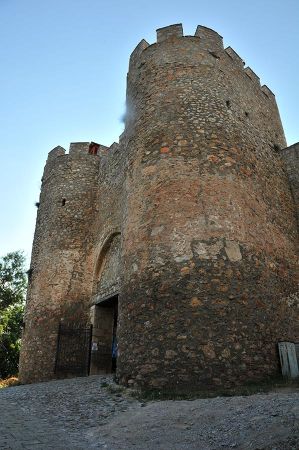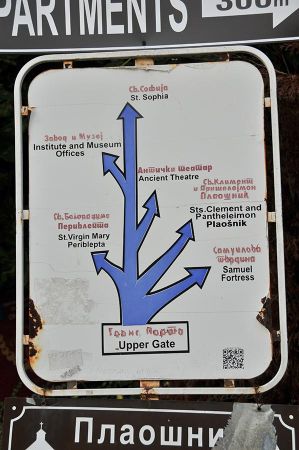When we arrived at the campsite in Struga, we admired the mighty walls of the fortress high above the old town centre of Ohrid. Now we were on our way to take a closer look at the fortress complex of Byzantine origin.
We parked our vehicle again in the city centre because we wanted to go through the old town up to the city hill. So, we used the wooden path along the cliffs again, not without stopping at one of the beach cafes, and then climbed the city hill to get to the fortress through the pine trees and sequoias, which are densely packed together to form the green lung of Ohrid.
Ohrid was briefly the capital of the First Bulgarian Empire
 At the time of Byzantine rule in parts of the Balkans, Ohrid had again become an important trading city after the Roman era and at the same time had developed into a cultural centre that was known far beyond the imperial borders. During this time, Ohrid was an important central point of Slavic culture - the first Slavic university was founded here in 893 by Bishop Clement of Ohrid. He was also Cyril and Methodius's mentor, who worked here in Ohrid. In the 10th century, Ohrid even briefly became the capital of the First Bulgarian Empire. Since then, Ohrid has also been a bishop's seat - which did not change until 1767. Around 300 churches were built and many valuable art treasures were created - unfortunately much of it was gradually destroyed or painted over during the Ottoman period.
At the time of Byzantine rule in parts of the Balkans, Ohrid had again become an important trading city after the Roman era and at the same time had developed into a cultural centre that was known far beyond the imperial borders. During this time, Ohrid was an important central point of Slavic culture - the first Slavic university was founded here in 893 by Bishop Clement of Ohrid. He was also Cyril and Methodius's mentor, who worked here in Ohrid. In the 10th century, Ohrid even briefly became the capital of the First Bulgarian Empire. Since then, Ohrid has also been a bishop's seat - which did not change until 1767. Around 300 churches were built and many valuable art treasures were created - unfortunately much of it was gradually destroyed or painted over during the Ottoman period.
After the conqueror and builder Samuel came the Turks
 However, for a brief period in the early 11th century, Ohrid also became the capital of a Slavic Bulgarian empire led by Czar Samuel. Samuel had a mighty fortress built above the old town, which cleverly integrated the city hill into the castle's defence concept. With its fortification walls up to 16 meters high and a total length of more than 3 kilometres, this castle complex was once one of the most powerful fortresses in the entire Balkans. The remains of what were once 18 towers and four city gates are still clearly visible in the cityscape of Ohrid today.
However, for a brief period in the early 11th century, Ohrid also became the capital of a Slavic Bulgarian empire led by Czar Samuel. Samuel had a mighty fortress built above the old town, which cleverly integrated the city hill into the castle's defence concept. With its fortification walls up to 16 meters high and a total length of more than 3 kilometres, this castle complex was once one of the most powerful fortresses in the entire Balkans. The remains of what were once 18 towers and four city gates are still clearly visible in the cityscape of Ohrid today.
Strategically located, the entire area and also the city of Ohrid were very easy to see, so today the castle complex can be seen as a wonderful vantage point over Lake Ohrid and the surrounding mountains. A climb to the fortress is always worthwhile.
Hellenistic Theater of the City of Ohrid
Over the centuries there were sometimes gigantic changes in the structural structure of the fortress, so that the walls had to be renewed or rebuilt in a different position. Of course, the owners of the fortress changed over the centuries and everyone probably had their own ideas and ideas. The fortress experienced a history that was just as eventful as the city itself: after the conqueror and builder Samuel came the Turks and with them the cannons. The fortress had to be additionally reinforced on the land side, which was not necessary on the sea side.
Follow Castle Street down into the town of Ohrid and you will reach one of the striking city gates. A section of the original road surface can still be seen here. Walking towards the harbour, after a few hundred meters you will reach the Hellenistic theatre of the city of Ohrid. Despite the fact that it is only partially uncovered and restored, it is still used for performances today. In the peripheral areas you can see finds that give an idea of what else will be in the ground here.
In the old town itself there are ups and downs, the paths are narrow and often there are stairs or simple ramps involved. One of the main streets through the town still shows the original paving in all its glory. The Bulevar Makedonski Prosvetitlei runs straight from the harbour - the actual boulevard of the city, which unfortunately loses much of its splendour due to the parking spaces. A few meters away from the harbour is Sveti Kliment Ohridski - a pedestrian zone with countless shops and street cafes.
A final stroll through the city's bazaar is also recommended.
Please read as well:
Amsterdam - By boat through the canals
Hike Bastei Bridge - starting point Rathen an der Elbe
Caravanning Festival Warsaw and the Big Five family

